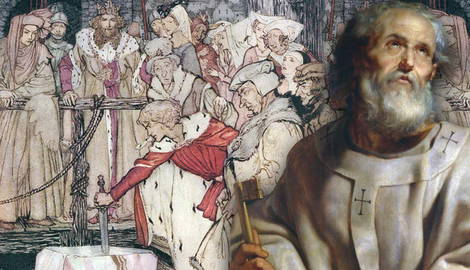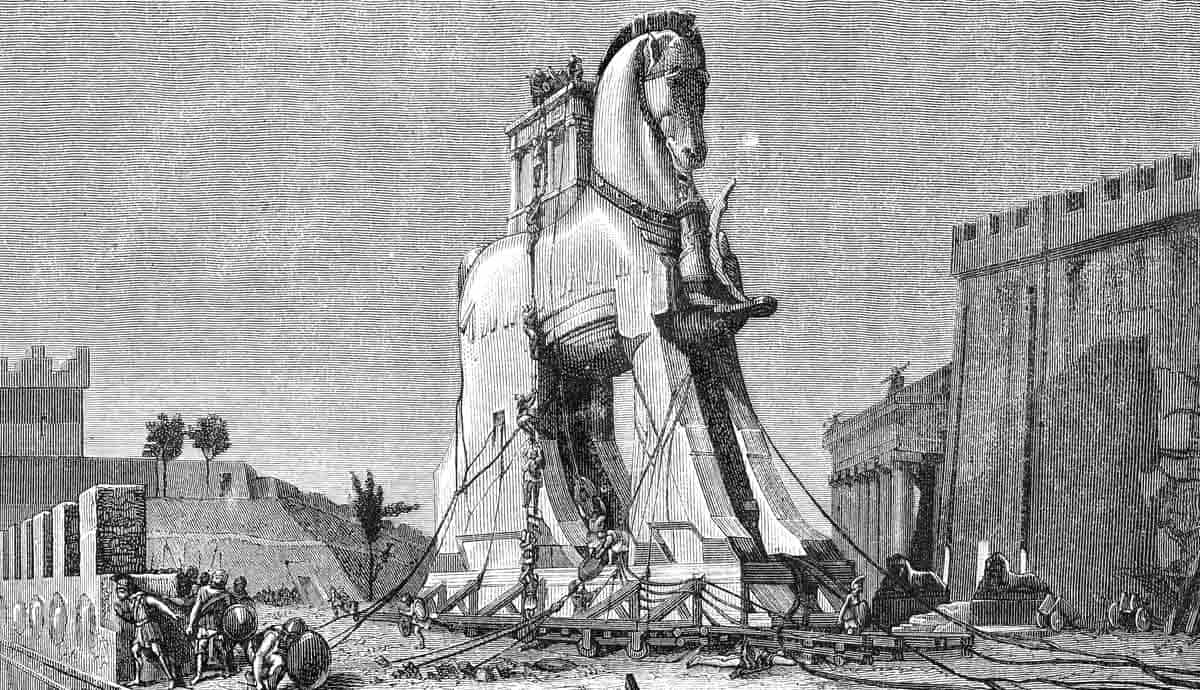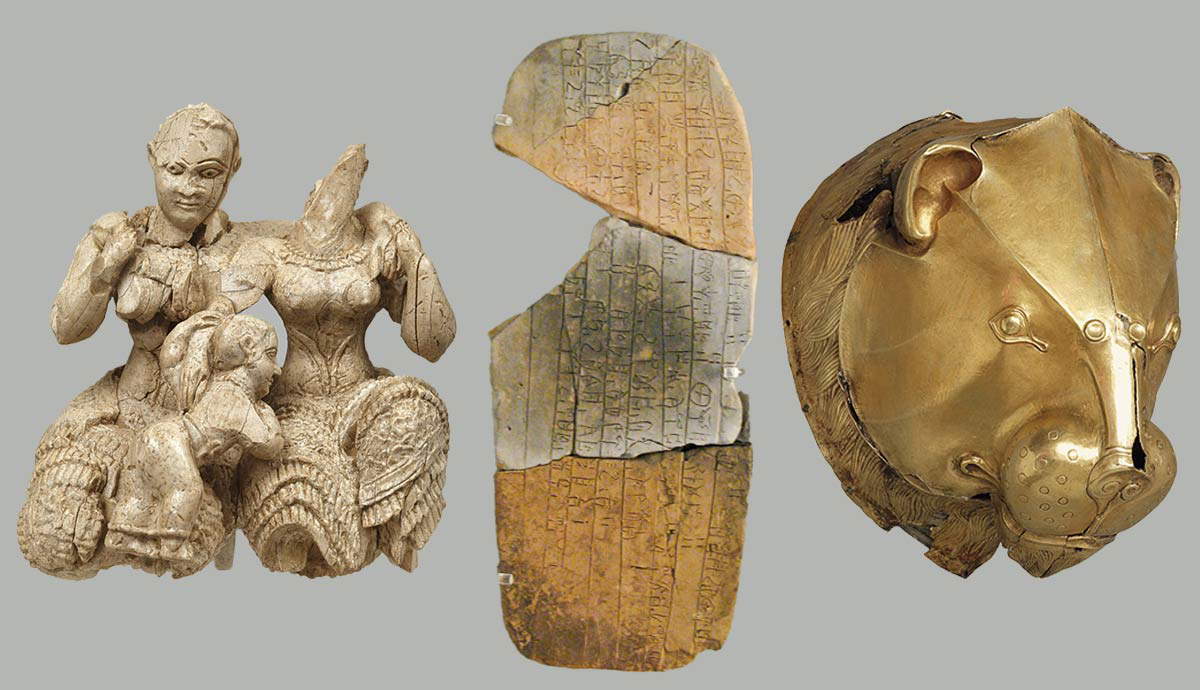
Within the legends of King Arthur, undoubtedly one of the most famous aspects is the story of the Sword in the Stone. Per the legend, there was a sword that was stuck through an anvil and into a large stone which no one could remove. On the sword, there was a brief explanation that only the rightful king of Britain could remove the sword from the stone. All the strong men of the land tried to remove it, but no one could. One day, while going to fetch his older brother’s sword for a competition, a young Arthur came across the sword and innocently took it. This reveals to everyone that Arthur was the rightful king. There are many theories about the origin of this story. Some researchers see it as a distortion of some ancient or medieval ceremony. However, there is good reason to suppose that this story may have been designed specifically to convey some Biblical symbolism.
Suggested Explanations for the Sword in the Stone

Firstly, let us consider some of the common explanations given regarding the legend of the Sword in the Stone. One popular idea is that it is a distorted memory of an accession ceremony that took place among the Irish kings of Dal Riada. This is particularly used in conjunction with the theory that the real King Arthur was a historical figure known as Artuir mac Aedan. He was a real prince who lived in Scotland in the late sixth century. Supposedly, the accession ceremony of this dynasty involved a sword and a special stone, called the Stone of Scone (or Stone of Destiny). Memories of this ceremony may have evolved into a story of a sword being removed from the stone by the rightful king.
Unfortunately, there is no record that this accession ceremony ever actually involved a sword. In reality, the new king would simply kneel or step onto the stone to be recognized. There was no sword involved. Therefore, there is no factual basis for associating this Dark Age ceremony with the legend of the Sword in the Stone.

Another explanation is that the legend comes from a different ceremony involving a special stone. There is a special stone in London called the London Stone. Nothing about the stone itself is especially remarkable, but there is a lot of controversy regarding its origin. In any case, it has been a famous part of London for centuries. In 1450, the leader of a rebellion against the monarchy, Jack Cade, marched to London with his followers. He went up to the London Stone, struck it with his sword, and declared himself the new lord of the city.
Some researchers have tried to argue that Jack Cade was performing a standard accession ceremony that was done among the mayors of London. The theory then goes that this ceremony may have originated as far back as the early Dark Ages, and this may have actually been something that Arthur did himself. The big problem with this theory is that there is no record of any mayor of London doing this before or after Jack Cade. There is no indication that this was an actual tradition, and thus no reason whatsoever to think that this event might have been something that was done in the Dark Ages.

One explanation which has grown in popularity in recent years is that the Arthurian Sword in the Stone comes from the legend of Saint Galgano. He was a religious figure from Tuscany in Italy who lived in the twelfth century, just before the first Arthurian story about the Sword in the Stone came about. Allegedly, a heavenly voice incited him to strike his sword into the bedrock on which he was standing. His sword got stuck there, and it remains there to this day.
Some researchers view it as very conspicuous that this allegedly happened just before the first reference to the Sword in the Stone in the Arthurian legends. However, it is difficult to see how the two could be connected. After all, Galgano plunged his sword into the stone; he did not take it out. Furthermore, his sword had nothing whatsoever to do with kingship. Therefore, it is very unlikely that there is any true connection here.
Strong Biblical Symbolism in the Arthurian Legend

In the Arthurian legend of the Sword in the Stone, there is plenty of obvious Biblical symbolism. Right from the start of the story, there is the fact that the Sword in the Stone appears in a churchyard on Christmas Eve. The time and place immediately indicate that it has religious significance. Furthermore, the words written on the side of the sword say:
“Who takes this sword out of this stone should be king by the election of Jesus Christ.”
Again, we see an explicit connection to Christianity. The archbishop is prominent throughout the story, casting holy water onto the stone, reading the words to the people, and just generally taking the lead regarding what is or is not done concerning the sword. After Arthur removes the sword from the stone, the people struggle to believe that he is really the chosen king. Therefore, the archbishop gets Arthur to repeat his act at the important church festivals of the year.
The Sword of Saint Peter

There are countless references to Jesus Christ and God throughout the earliest account of the legend of the Sword in the Stone. However, one statement in particular seems especially noteworthy. The archbishop says to Arthur:
“Fetch the sword with which you shall keep justice, to defend the Holy Church, and maintain right and the Christian faith to your power.”
In the archbishop’s description of the sword, he does not actually mention kingship directly. Rather, he refers to the sword as being used to “defend the Holy Church” and “maintain the Christian faith.” In doing so, he explicitly connects the sword with the Church and Christianity. It seems clear that the sword is connected to religious authority, at least in a certain sense. It certainly is related to religious responsibility, whether that involves authority over others in a religious sense or not. This may suggest that the Sword in the Stone is actually just as much about religion as it is about kingship.

Interestingly, the Bible occasionally uses the sword as a symbol of authority. In church tradition, such symbolism became so strong that it led to something known as the doctrine of the two swords. This is a doctrine concerning the authority of the pope and the emperor, in which the “two swords” represent the two different kinds of authority. The pope has religious authority, while the emperor has political authority.
It is interesting to note what the sword of religious authority was sometimes called. The tenth-century king of England, Edgar, is reported to have said to his clergy that he possessed the sword of Constantine, while they possessed the sword of Peter. Their authority was called the “sword of Peter” due to the belief that Jesus had given the Apostle Peter preeminent authority over his congregation. Thus, those with religious authority (such as the clergy or the pope) could be said to possess “the sword of Peter.”
The Meaning of Peter’s Name

Famously, the name “Peter” comes directly from the Greek word for “rock.” In fact, “stone” is just as appropriate a translation, even though “rock” has traditionally been favored. Due to a famous passage in the Gospels in which Jesus refers to the meaning of Peter’s name, this is not an obscure piece of trivia. The Church has always remembered that “Peter” means “rock,” or “stone.” This leads to a very real possibility regarding the Sword in the Stone. Recall the abundant religious context in which the sword appears, as well the fact that the archbishop refers to it as if it were specifically meant for defending Christianity. On this basis, it can be argued that the Sword in the Stone was actually a symbol of religious authority.
Some might object to this on the basis that the sword is actually said to go through an anvil and then a stone. However, the anvil is clearly incidental to the story. In the original narrative itself, the sword is definitely described as being “fixed into the stone,” with the anvil ignored. The anvil is also ignored in the writing on the side of the sword.
How King Arthur Possessed the Sword of Peter

In the Arthurian legend, it is only the rightful king who can possess the Sword in the Stone. In the story, this turns out to be Arthur. How does the idea that the sword represents religious authority work in Arthur’s case? Well, we know that the world of Arthur emerged from the collapse of the Western Roman Empire in Britain. One of Arthur’s legendary predecessors, Ambrosius Aurelianus, was historically a child of a father who “wore the purple,” denoting imperial authority. Arthur himself is called “emperor” in Welsh tradition.
We know that in the Late Western Roman Empire, the emperor possessed the title “Pontifex Maximus,” which referred to the highest position of religious authority. Eventually, the emperors of the West continued using this title (and then an altered version, “Pontifex Inclytus”) until the end of the Western Roman Empire. Perhaps it continued to be used in early Dark Age Britain for a while among self-proclaimed emperors. Thus, in Arthur’s era, it well may be that the high kings were the ones who possessed supreme religious authority.
How the Bible Explains the Sword in the Stone

In conclusion, the Bible presents us with some information that may be crucial to understanding the legend of the Sword in the Stone. It uses the sword as a symbol of authority, and this usage gained popularity throughout medieval times. The expression “the sword of Peter” was sometimes used to denote religious authority. Given that “Peter” means “rock,” or “stone,” the idea of religious authority may have been presented symbolically in the form of a sword in a stone. Since Arthur was an emperor according to Welsh tradition, it would not be surprising if he carried the title “pontifex inclytus.” Whether he had such an official title or not, he may have been viewed as possessing the supreme religious authority that the emperors of Rome historically had. Therefore, as the rightful heir (according to the legend), he was the only one who could possess the figurative “sword of Peter.” We may never know what the earliest writer of the Sword in the Stone legend really had in mind, but the extensive religious language used supports this explanation.










